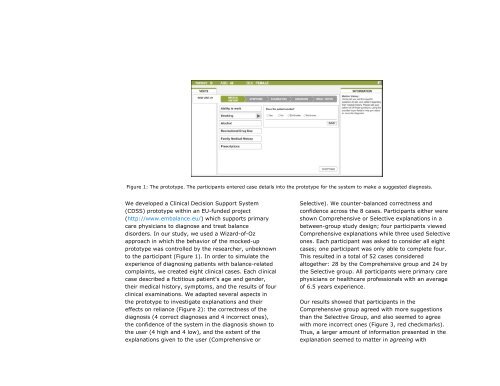Explanations Considered Harmful? User Interactions with Machine Learning Systems
HCML2016_paper_2
HCML2016_paper_2
You also want an ePaper? Increase the reach of your titles
YUMPU automatically turns print PDFs into web optimized ePapers that Google loves.
Figure 1: The prototype. The participants entered case details into the prototype for the system to make a suggested diagnosis.<br />
We developed a Clinical Decision Support System<br />
(CDSS) prototype <strong>with</strong>in an EU-funded project<br />
(http://www.embalance.eu/) which supports primary<br />
care physicians to diagnose and treat balance<br />
disorders. In our study, we used a Wizard-of-Oz<br />
approach in which the behavior of the mocked-up<br />
prototype was controlled by the researcher, unbeknown<br />
to the participant (Figure 1). In order to simulate the<br />
experience of diagnosing patients <strong>with</strong> balance-related<br />
complaints, we created eight clinical cases. Each clinical<br />
case described a fictitious patient's age and gender,<br />
their medical history, symptoms, and the results of four<br />
clinical examinations. We adapted several aspects in<br />
the prototype to investigate explanations and their<br />
effects on reliance (Figure 2): the correctness of the<br />
diagnosis (4 correct diagnoses and 4 incorrect ones),<br />
the confidence of the system in the diagnosis shown to<br />
the user (4 high and 4 low), and the extent of the<br />
explanations given to the user (Comprehensive or<br />
Selective). We counter-balanced correctness and<br />
confidence across the 8 cases. Participants either were<br />
shown Comprehensive or Selective explanations in a<br />
between-group study design; four participants viewed<br />
Comprehensive explanations while three used Selective<br />
ones. Each participant was asked to consider all eight<br />
cases; one participant was only able to complete four.<br />
This resulted in a total of 52 cases considered<br />
altogether: 28 by the Comprehensive group and 24 by<br />
the Selective group. All participants were primary care<br />
physicians or healthcare professionals <strong>with</strong> an average<br />
of 6.5 years experience.<br />
Our results showed that participants in the<br />
Comprehensive group agreed <strong>with</strong> more suggestions<br />
than the Selective Group, and also seemed to agree<br />
<strong>with</strong> more incorrect ones (Figure 3, red checkmarks).<br />
Thus, a larger amount of information presented in the<br />
explanation seemed to matter in agreeing <strong>with</strong>


